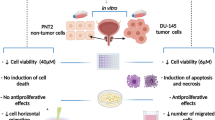Abstract
Plants, due to their remarkable composition, are considered as natural resources of bioactive compounds with specific biological activities. Salvia genus (Lamiaceae) has been used around the world in complementary medicine since ancient times. We investigated the cytotoxic, apoptotic and anti-angiogenic effects of methanolic Salvia triloba extract (STE) in prostate cancer cells. Cell viability was evaluated by XTT; apoptosis was investigated by DNA fragmentation and caspase 3/7 activity assays. Changes in the angiogenic cytokine levels were investigated by human angiogenesis antibody array. Scratch assay was used to determine the cell motility. STE induced cytotoxicity and apoptosis in a concentration-dependent manner in both cancer cells; however, it was not cytotoxic to normal cells. Cell motility was reduced in PC-3, DU-145 and HUVEC cells by STE treatment. ANG, ENA-78, bFGF, EGF, IGF-1 and VEGF-D levels were significantly decreased by −2.9, −3.7, −1.7, −1.7, −2.0 and −1.8 fold in STE-treated DU-145 cells, however, ANG, IL-8, LEP, RANTES, TIMP-1, TIMP-2 and VEGF levels were significantly decreased by −5.1, −2.0, −2.4, −3.1, −1.5, −2.0 and −2.5 fold in PC-3 cells. These data suggest that STE might be a promising candidate for anti-tumor and anti-angiogenic treatment of prostate cancer.





Similar content being viewed by others
References
Chan HH, Hwang TL, Su CR, Reddy MV, Wu TS. Anti-inflammatory, anticholinesterase and antioxidative constituents from the roots and the leaves of Salvianipponica Miq. var. Formosan. Phytomedicine. 2011;15:148–50.
Fiore G, Nencini C, Cavallo F, Capasso A, Bader A, Giorgi G, et al. In vitro antiproliferative effect of six Salvia species on human tumor cell lines. Phytother Res. 2006;20:701–3.
Gong Y, Li Y, Lu Y, Li L, Abdolmaleky H, Blackburn GL, et al. Bioactive tanshinones in Salvia miltiorrhiza inhibit the growth of prostate cancer cells in vitro and in mice. Int J Cancer. 2011;1:1042–52.
Hayat MA. (2011). Tumors of the central nervous system, Vol 12. USA.
Tiwari M. Apoptosis: Angiogenesis and Cancer Therapies. J Cancer Ther Res. 2012;1:1–3.
Karaca B, Kucukzeybek Y, Gorumlu G, Erten C, Gul MK, Cengiz E, et al. Profiling of angiogenic cytokines produced by hormone- and drug –refractory prostate cancer cell lines, PC-3 and DU-145 before and after treatment with gossypol. Eur Cytokine Netw. 2008;1:176–84.
Liang CC, Park AY, Guan JL. In vitro scratch assay: a convenient and inexpensive method for analysis of cell migration in vitro. Nat Protoc. 2007;2:329–33.
Keshavarz M, Mostafaie A, Mansouri K, Bidmeshkipour A, Motlagh HR, Parvaneh S. In vitro and ex vivo antiangiogenic activity of Salvia officinalis. Phytother Res. 2010;24:1526–31.
Mohan R, Hammers HJ, Bargagna-Mohan P, Zhan XH, Herbstritt CJ, Ruiz A, et al. Withaferin A is a potent inhibitor of angiogenesis. Angiogenesis. 2004;7:115–22.
Horiuchi K, Shiota S, Hatano T, Yoshida T, Kuroda T, Tsuchiy T. Antimicrobial activity of oleanolic acid from Salvia officinalis and related compounds on vancomycin resistant enterococci (VRE). Biol Pharm Bull. 2007;30:1147–9.
Shakiba Y, Mansouri K, Mostafaie A. Anti-angiogenic effect of soybean kunitz trypsin inhibitor on human umbilical vein endothelial cells. Fitoterapia. 2007;78:587–9.
Bors W, Michel C, Stettmaier K, Lu Y, Foo LY. Antioxidant mechanisms of polyphenolic caffeic acid oligomers, constituents of Salvia officinalis. Biol Res. 2004;37:301–11.
Moretti MDL, Peana AT, Sata M. A study on anti-inflammatory and peripheral analgesic action of Salvia sclarea oil and its main components. JEOR. 1997;9:199–204.
Skjøth IH, Issinger OG. Profiling of signaling molecules in four different human prostate carcinoma cell lines before and after induction of apoptosis. Int J Oncol. 2006;28:217–29.
Papageorgiou V, Gardeli C, Mallouchos A, Papaioannou M, Komaitis M. Variation of the Chemical Profile and Antioxidant Behavior of Rosmarinus officinalis L. and Salvia fruticosa Miller Grown in Greece. J Agric Food Chem. 2008;56:7254–64.
Al-Kalaldeh JZ, Abu-Dahab R, Afifi FU. Volatile oil composition and antiproliferative activity of Laurus nobilis, Origanum syriacum, Origanum vulgare, and Salvia triloba against human breast adenocarcinoma cells. Nutr Res. 2010;30:271–8.
Kaileh M, Vanden Berghe W, Boone E, Essawi T, Haegeman G. Screening of indigenous Palestinian medicinal plants for potential anti-inflammatory and cytotoxic activity. J Ethnopharmacol. 2007;25:510–6.
Xavier CP, Lima CF, Fernandes-Ferreira M, Pereira-Wilson C. Salvia fruticosa, Salvia officinalis, and rosmarinic acid induce apoptosis and inhibit proliferation of human colorectal cell lines: the role in MAPK/ERK pathway. Nutr Cancer. 2009;61:564–71.
Li S, Ibaragi S, Hu GF. Angiogenin as a molecular target for the treatment of prostate cancer. Curr Cancer Ther Rev. 2011;7:83–90.
Nissen LJ, Cao R, Hedlund EM, Wang Z, Zhao X, Wetterskog D, et al. Angiogenic factors FGF2 and PDGF-BB synergistically promote murine tumor neovascularization and metastasis. J Clin Invest. 2007;117:2766–77.
Gleissner CA, von Hundelshausen P, Ley K. Platelet chemokines in vascular disease. Arterioscler Thromb Vasc Biol. 2008;28:1920–7.
George DJ, Halabi S, Shepard TF, Vogelzang NJ, Hayes DF, Small EJ, et al. Cancer and Leukemia Group B 9480. Prognostic significance of plasma vascular endothelial growth factor levels in patients with hormone-refractory prostate cancer treated on Cancer and Leukemia group B 9480. Clin Cancer Res. 2001;7:1932–6.
Acknowledgments
This research was done at Medical Oncology Research Laboratories, School of Medicine, Tulay Aktas Oncology Hospital, Ege University. We thank Naturin Natural Products Ltd. (Izmir, Turkey) for supplying the plant material.
Author information
Authors and Affiliations
Corresponding author
Ethics declarations
The authors claim no conflict of interests.
Rights and permissions
About this article
Cite this article
Atmaca, H., Bozkurt, E. Apoptotic and anti-angiogenic effects of Salvia triloba extract in prostate cancer cell lines. Tumor Biol. 37, 3639–3646 (2016). https://doi.org/10.1007/s13277-015-4208-2
Received:
Accepted:
Published:
Issue Date:
DOI: https://doi.org/10.1007/s13277-015-4208-2




